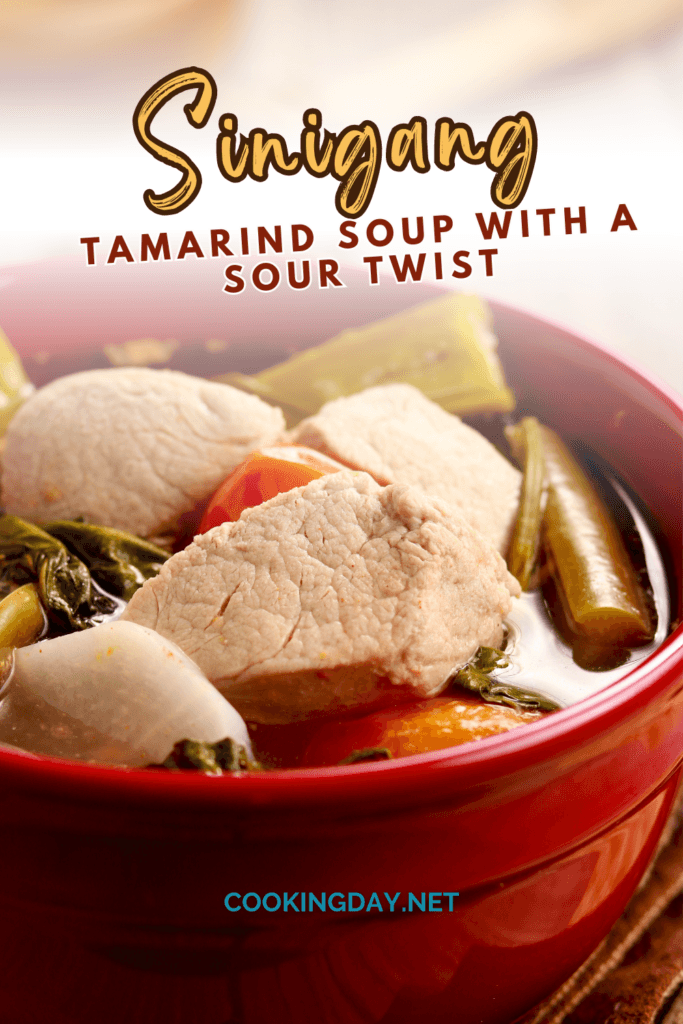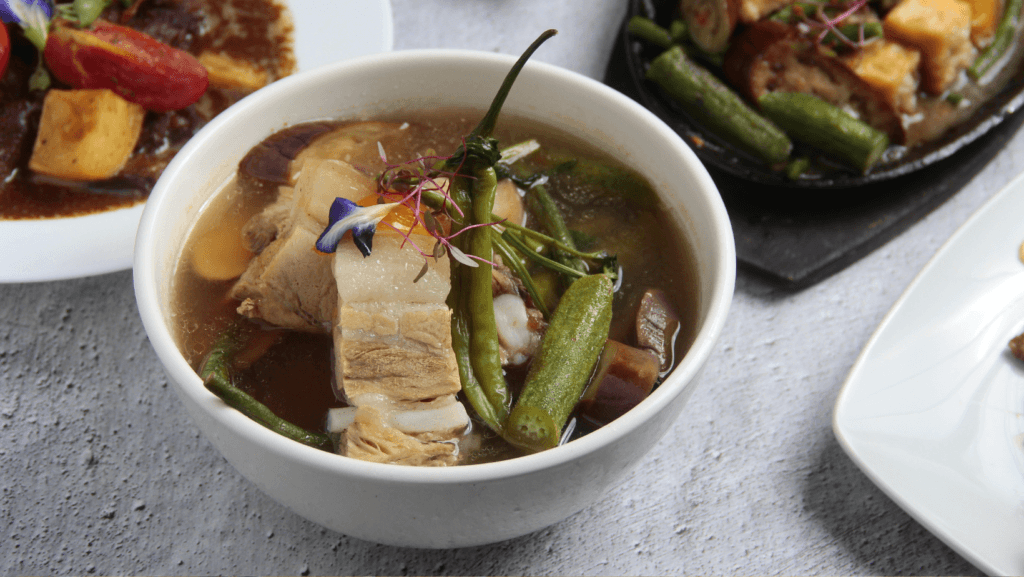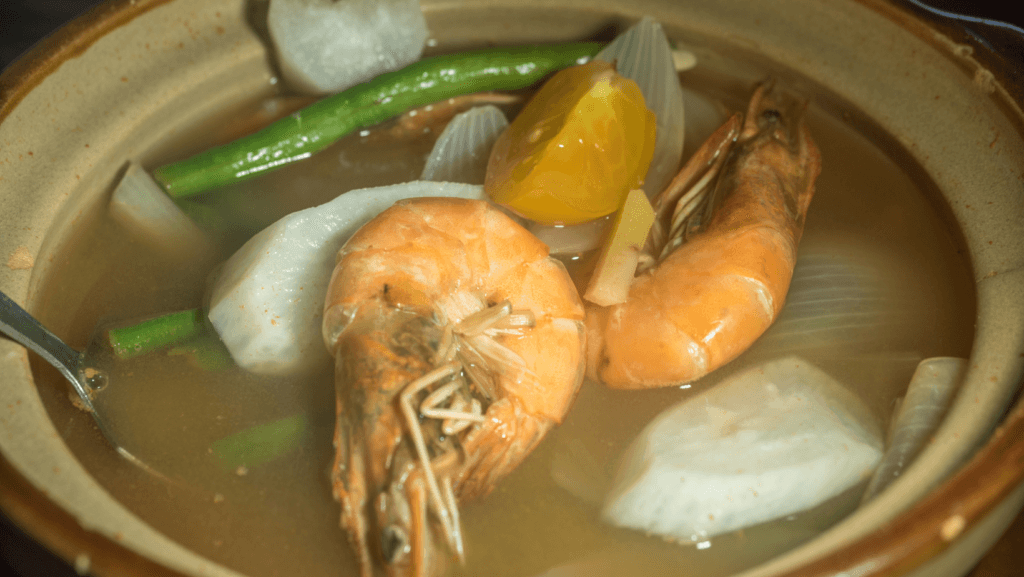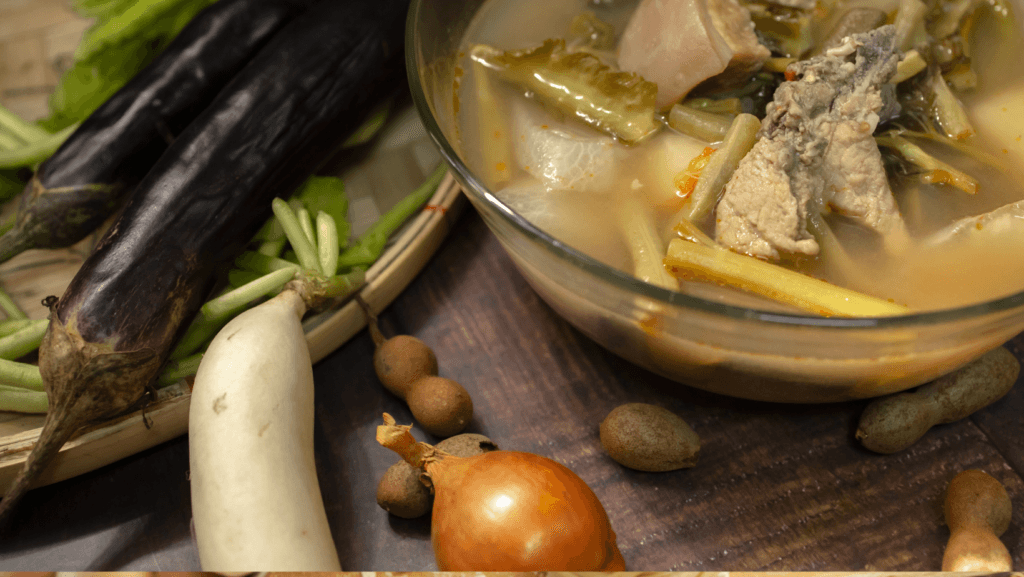Some links on this page are affiliate links. This means we may earn a commission at no additional cost to you if you click through and make a purchase, you can check our Affiliate Disclosure. Thank you for your support!
Let’s talk about Sinigang, a classic Filipino soup that’s all about a delicious sour kick. It’s not just a dish; it’s a big part of Filipino food culture. It is a cozy, comforting soup, perfect for any day. It’s known for its unique sour taste, usually from tamarind, and it’s loaded with veggies and meat. In this post, we’re going to explore what Sinigang is all about, from its key ingredients to some cool ways to make it at home. Whether you’re a Sinigang newbie or a seasoned fan, there’s something here for everyone. Let’s get started! 🍲

Understanding Sinigang: A Staple in Filipino Cuisine
It isn’t just a dish; it’s a piece of Filipino culture. Let’s dive into its history and what makes it a must-try.
The History of Sinigang
- Origins: It has been warming hearts in the Philippines for ages. It’s more than just food; it’s a part of family gatherings and everyday meals. The dish reflects the Philippines’ rich history, blending native cooking traditions with influences from other cultures.
- Cultural Significance: In Filipino culture, It represents home cooking at its finest. It’s a dish that brings families together, often passed down through generations.
- Regional Variations: Across the Philippines, It takes on different forms. Some regions use fruits like guava for sourness, while others might use calamansi. Each area adds its unique touch, making Sinigang a diverse and versatile dish.
The Basics of Sinigang
- Key Ingredients: At its heart, It includes a protein (like pork, fish, or shrimp), various vegetables (like water spinach, eggplant, and radish), and that all-important souring agent.
- Flavors: The real magic of it lies in its balance of sour and savory flavors. It’s a comforting, hearty dish with a refreshing sourness that makes you want more.
- Tamarind as the Star: Tamarind is often the go-to choice for that signature sour flavor in it. It gives the soup a distinct taste and a bit of tanginess that sets it apart from other soups.
The Art of Making Sinigang
Making Sinigang is like creating a piece of art. It’s all about choosing the right ingredients and balancing flavors. Let’s get into how you can whip up this comforting dish.
Choosing the Right Ingredients
- Meats and Vegetables: It is versatile. Commonly, people use pork, beef, or shrimp. For veggies, think water spinach, eggplant, radish, and tomatoes. Feel free to mix and match based on what you like!
- Tips on Selecting the Best Tamarind: Fresh tamarind is great for that authentic sour taste. Look for ones that are a bit soft. No fresh tamarind? No problem! Tamarind paste or even ready-made Sinigang mix can do the trick.
Step-by-Step Cooking Guide
- Prep Your Ingredients: Wash and cut your veggies. If you’re using meat, get it into bite-sized pieces.
- Cook the Meat: Start by boiling your choice of meat until it’s tender. This can take a while, so be patient!
- Add the Tamarind: Once the meat is ready, it’s time for the star of the show – tamarind. If you’re using fresh tamarind, you’ll need to boil and strain it first. For pastes or mixes, follow the package instructions.
- Vegetable Time: Add your veggies to the pot. Start with the ones that take longer to cook, like radish, then add the rest later.
- Seasoning and Adjusting Sourness: This is where you make it your own. Add salt or fish sauce to taste. If it’s not sour enough for you, add a bit more tamarind.
And there you have it! A pot of comforting, sour Sinigang perfect for any day. Remember, the key to a great Sinigang is in the balance of sourness and savory flavors.
Variations of Sinigang
Sinigang is a dish that loves to change it up! From pork to seafood, there’s a Sinigang for every taste. Let’s explore some of these tasty variations.
Sinigang na Baboy (Pork Sinigang)

Recipe Basics: For Pork Sinigang, you’ll start with pork ribs or belly – these cuts make the soup rich and flavorful. After boiling the pork until tender, add your tamarind base and a mix of veggies like kangkong (water spinach), radish, and tomatoes.
Unique Aspects: What sets Pork Sinigang apart is its hearty and robust flavor. The pork fat adds a lovely richness that balances the sourness of the tamarind.
Seafood and Other Variations

Sinigang na Hipon (Shrimp Sinigang): This version is lighter but equally delicious. Use fresh shrimp and cook them until they’re just right – tender and juicy. Shrimp cooks faster than pork, so keep an eye on it!
Vegetarian Options: Yes, you can make Sinigang without meat! Use mushrooms or tofu as your protein, and load up on veggies. It’s a refreshing twist on the classic.
Modern Twists: Feeling adventurous? Try using different souring agents like green mango or lemon. Some even add a little pineapple for a sweet-sour combo.
Sinigang’s beauty lies in its flexibility. Feel free to experiment and make it your own. Whether you stick to traditional recipes or add your twist, Sinigang is sure to comfort and delight. Happy cooking! 🍲🌿
Serving and Enjoying Sinigang
Sinigang is more than just a soup; it’s a whole experience. Let’s talk about the best ways to serve and enjoy this Filipino favorite, both at home and around the world.
Traditional Pairings and Serving Suggestions
- Common Side Dishes: A bowl of steaming white rice is Sinigang’s best friend. The rice soaks up the soup’s flavors, making each bite a delight. You can also pair it with a salty or fried side dish to contrast the sour soup.
- How to Serve Sinigang: Serve it hot and fresh. It’s common to have the soup in a large bowl in the center of the table, letting everyone help themselves. Don’t forget a bowl of rice for everyone!
Enjoying Sinigang Beyond the Philippines
- Adaptations in Different Countries: As Sinigang travels, it adapts. Chefs worldwide tweak the recipe to match local tastes, like using local souring agents or adding unique local ingredients.
- Global Appeal: The simplicity and heartiness of it have won hearts globally. It’s not just a Filipino dish anymore; it’s a world favorite. You might find it in restaurants or homes far from the Philippines, each with its unique twist.
Sinigang’s versatility makes it perfect for any table, anywhere in the world. Whether you’re keeping it traditional or trying something new, Sinigang is sure to bring a warm, sour, and satisfying experience.
The Health Benefits of Sinigang
Sinigang isn’t just tasty; it’s also packed with nutrients. Let’s break down the health benefits of this beloved Filipino soup.
Nutritional Value of Ingredients

- Tamarind: This sour superstar is more than just flavor. Tamarind is loaded with vitamins, like B vitamins, and is great for digestion.
- Vegetables: Sinigang is often brimming with veggies like radish, eggplant, and water spinach. These are not only high in fiber but also rich in vitamins and minerals.
- Meat and Fish: Whether you use pork, beef, or shrimp, these proteins add essential nutrients to the dish. They provide energy and help rebuild tissues.
Sinigang in a Balanced Diet
- Low-Calorie Comfort Food: Unlike many hearty soups, Sinigang is relatively low in calories. It’s filling without being heavy, making it a great choice for a balanced diet.
- Hydration and Digestion: The broth in Sinigang is not just delicious; it also helps keep you hydrated. Plus, the sourness can kickstart your digestion.
- Versatility for Healthier Choices: You can easily make it healthier by opting for leaner cuts of meat or increasing the number of veggies. It’s a flexible dish that can fit into various dietary needs.
It is a win-win; it’s comforting and good for you. Whether you’re enjoying a bowl on a rainy day or as part of your regular diet, this soup is a nutritious choice that doesn’t skimp on flavor. Enjoy your bowl of health and happiness! 🍲💚
To Wrap Up…
And there you have it – a deep dive into the world of Sinigang, a dish that’s not just food, but a piece of Filipino culture. We’ve explored its rich history, the art of making it, the exciting variations, and even its health benefits. It’s versatility and unique sour flavor make it a standout dish in any kitchen.
Now, it’s your turn to try making it at home! Whether you go for the classic Pork Sinigang, a seafood variant, or even a veggie-packed version, this dish is sure to bring a smile to your face. Don’t forget to play around with the ingredients and find the perfect balance of sour and savory that works for you.
We’d love to hear about your Sinigang adventures! Share your cooking experiences, your favorite variations, or any special tips you’ve discovered. Let’s celebrate the joy of cooking and the delicious world of it together. Happy cooking! 🍲👩🍳👨🍳

